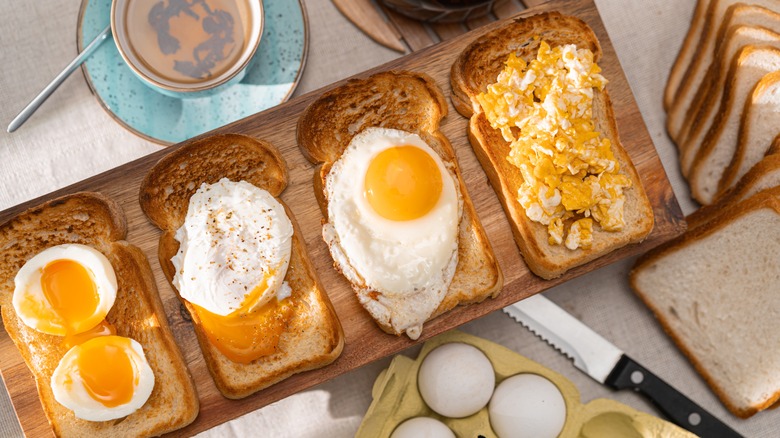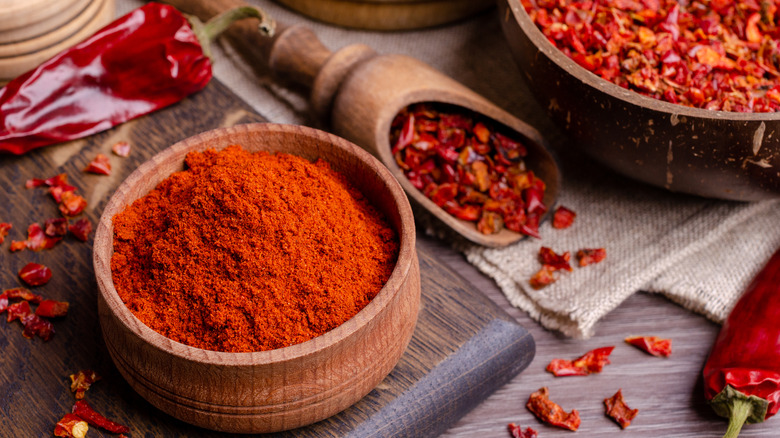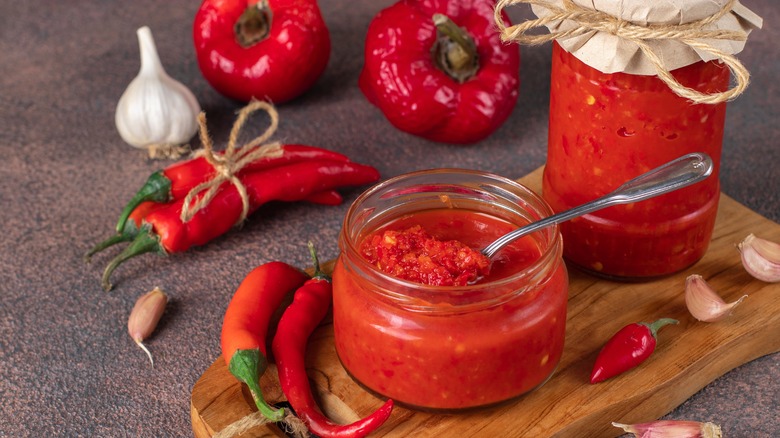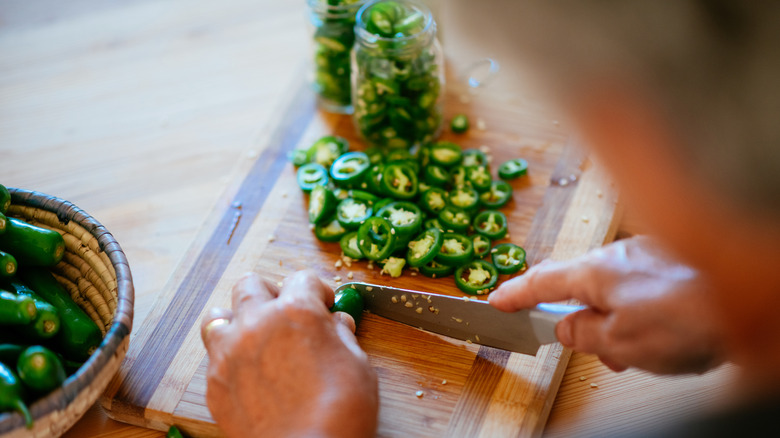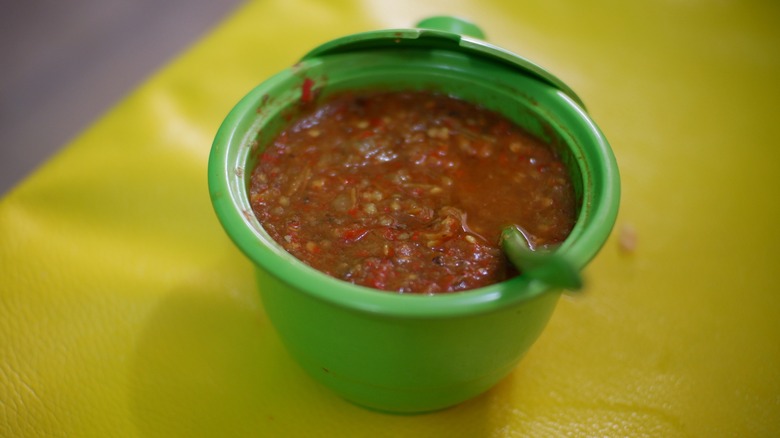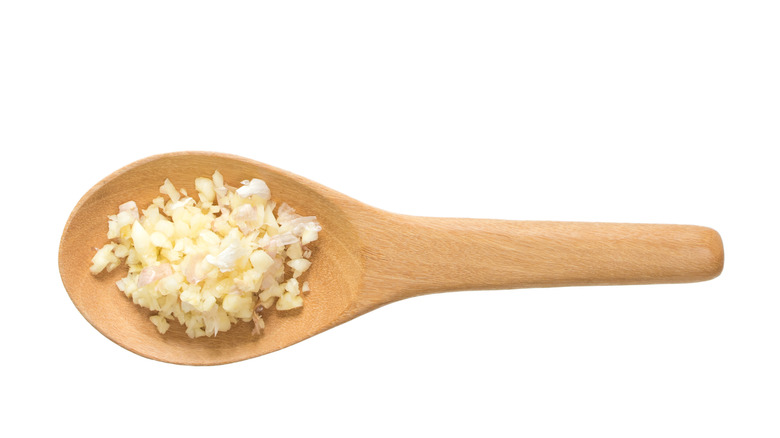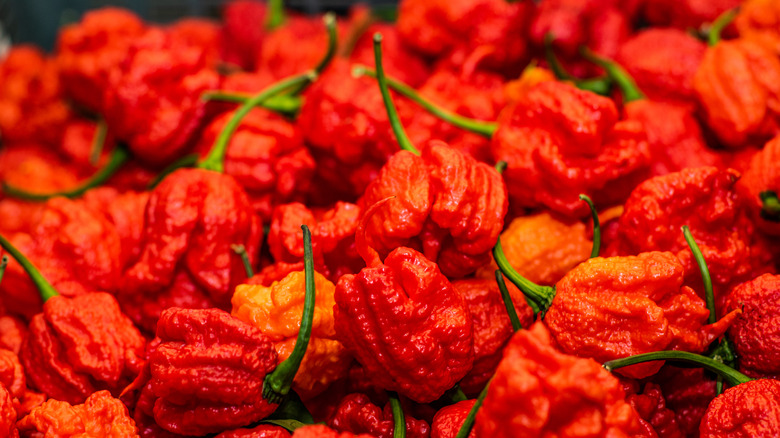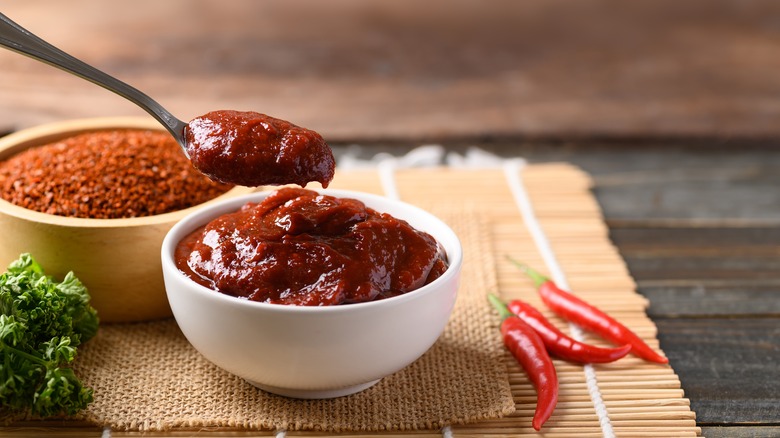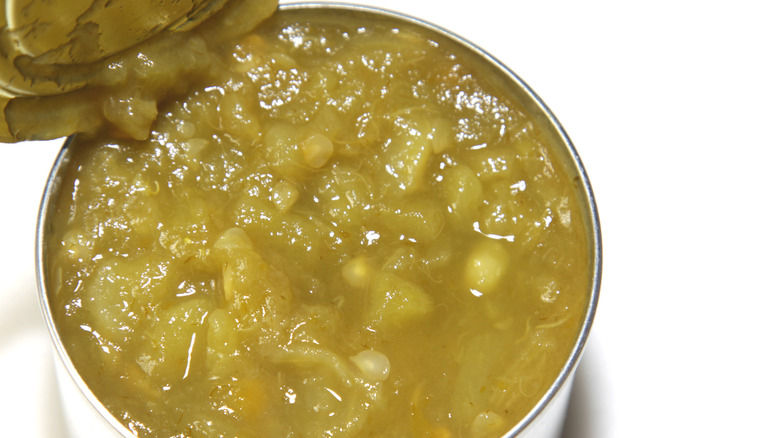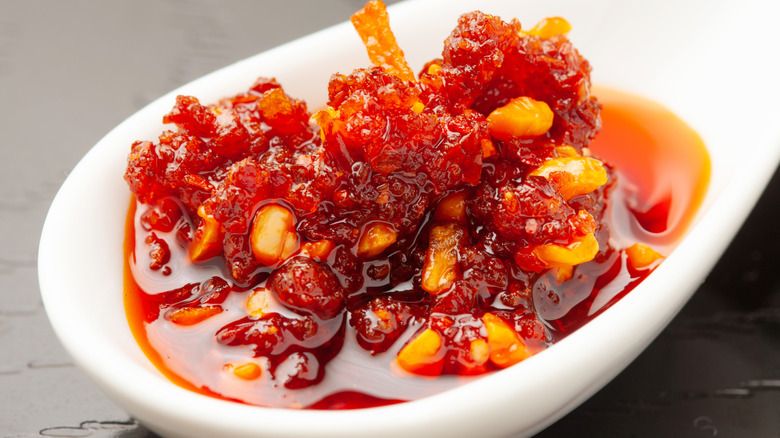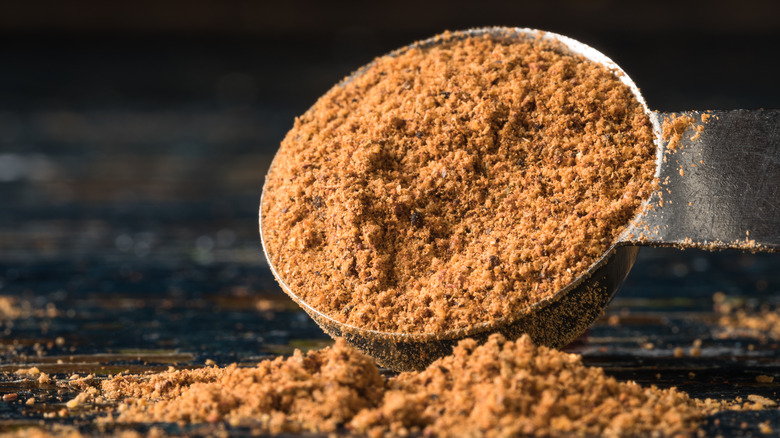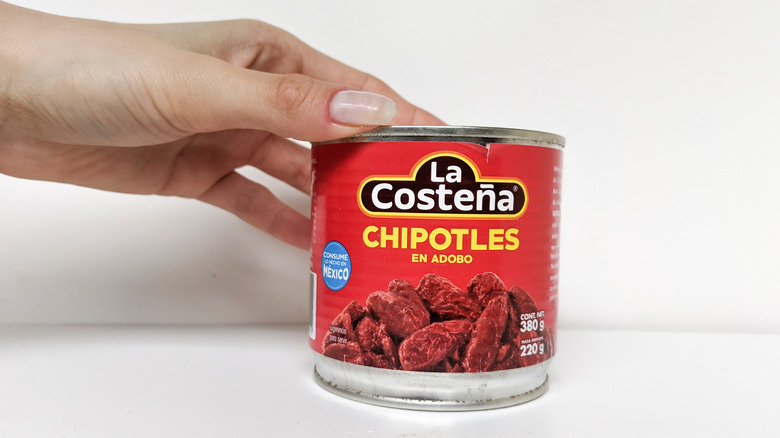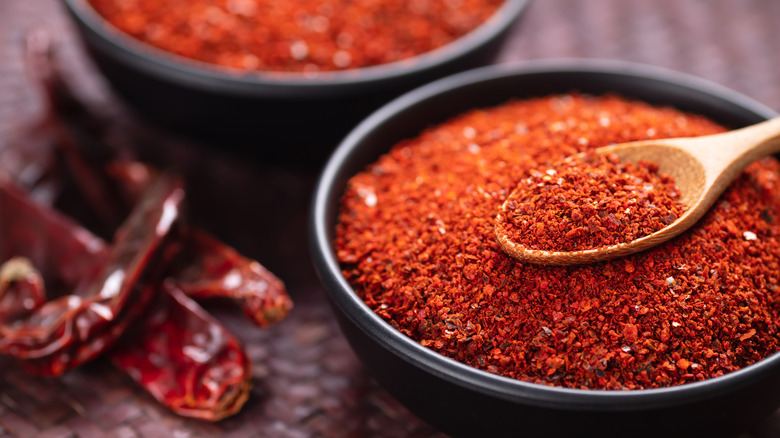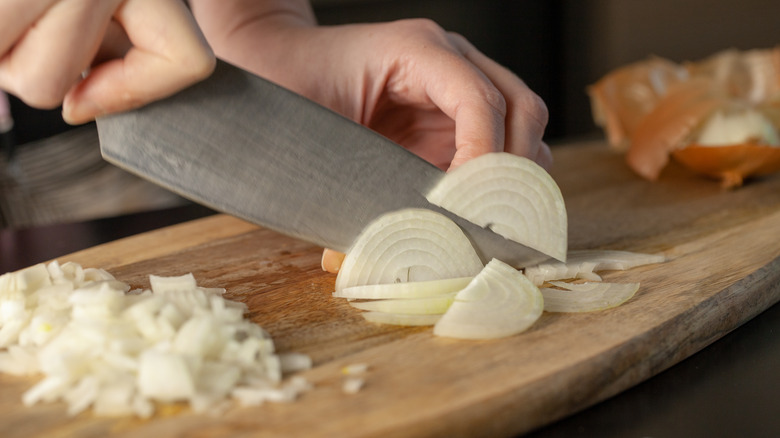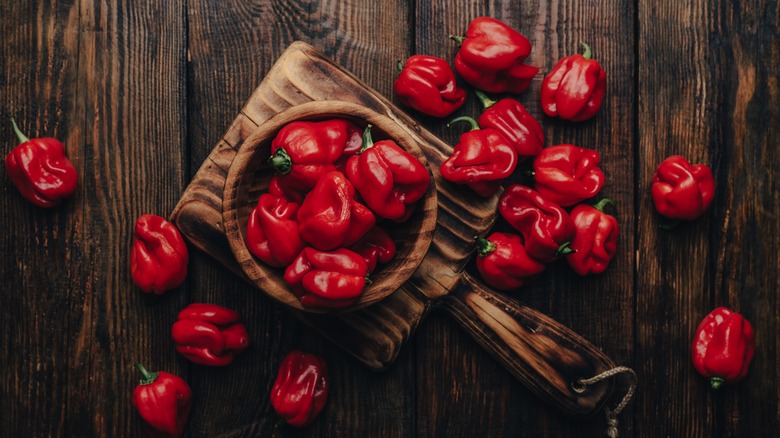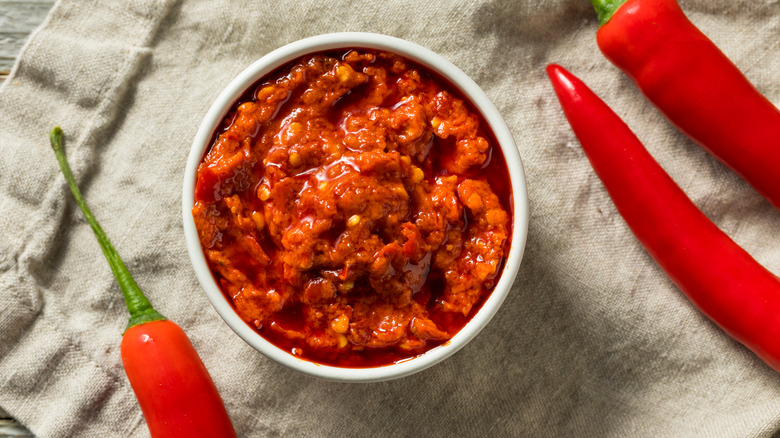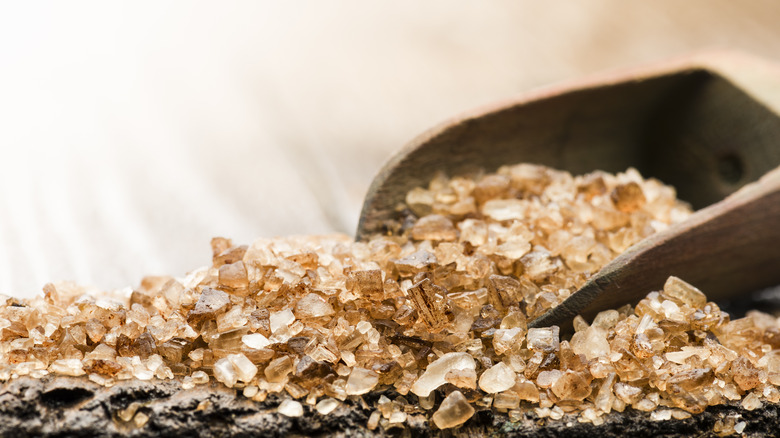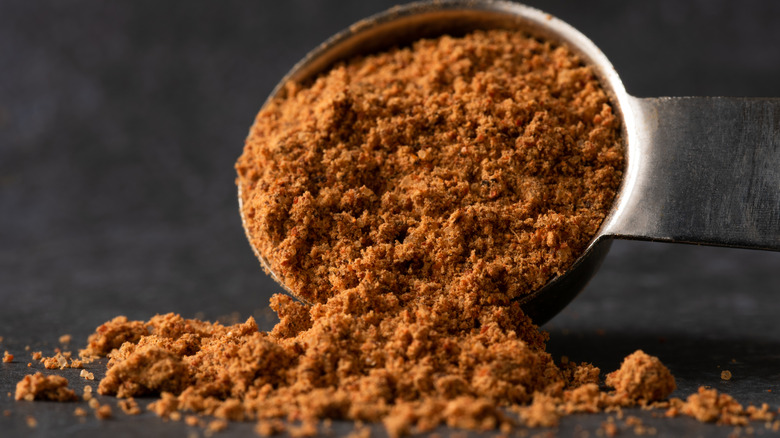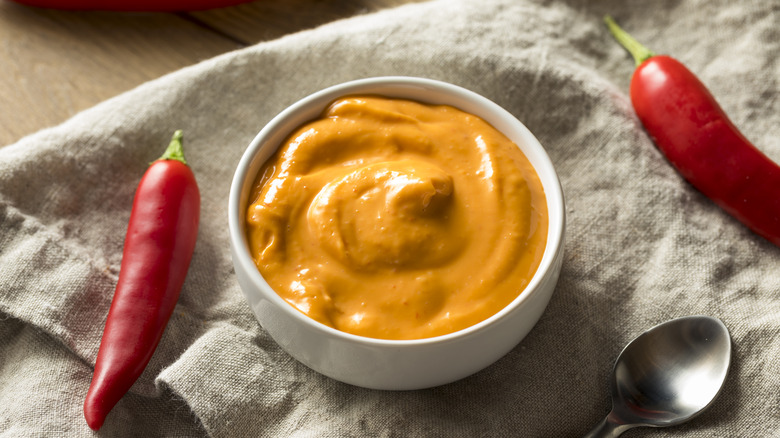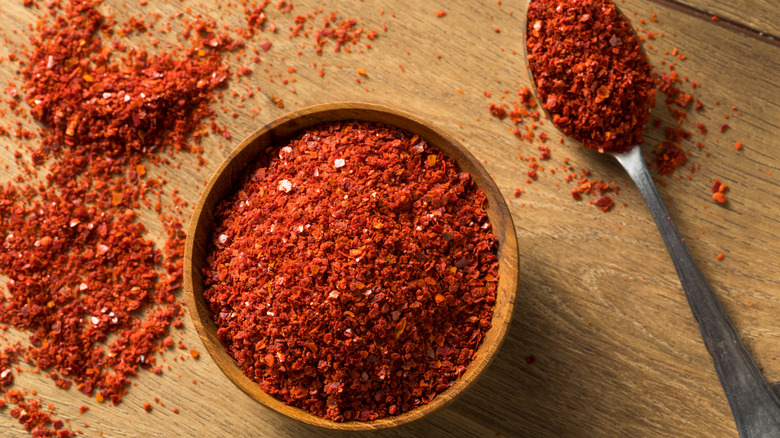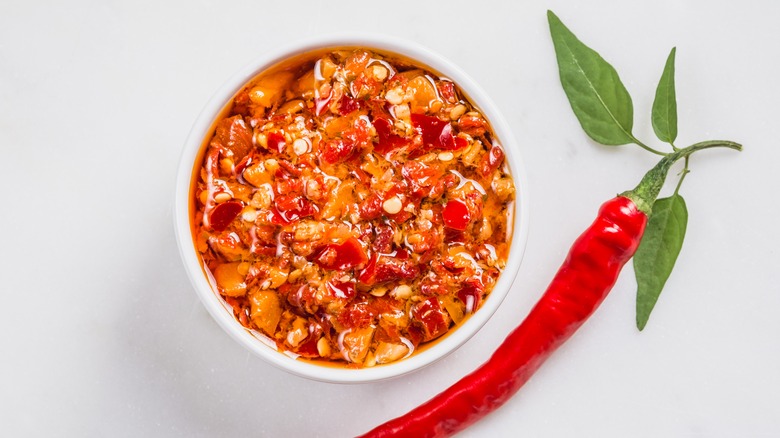22 Ways To Add Spice To Your Eggs
It's an age-old question with so many answers: "How do you like your eggs?"
There are countless ways to cook an egg: scrambled, poached, hard-boiled, sunny-side-up, and on and on. Versatile, tasty, and healthy, eggs provide an excellent way to round out breakfast (or really, any meal). Eggs are high in protein, rich in healthy fats, and contain quite a few essential vitamins and minerals like Vitamin A, iron, and folate. Additionally, while not vegan, eggs fall under the category of lacto-ovo vegetarianism, making them a great protein source for people who don't eat meat.
Eggs can taste wildly different, depending on the method used to prepare them. Hard and soft-boiled eggs take on a pungent taste and can smell like rotten eggs when no other ingredients are added. Scrambled eggs, while nutritious, can be bland without added seasoning, and while the yolks of a sunny-side up or poached egg are richly flavored (and Instagram gold), the whites don't taste like much. Thus, eggs are almost always served with other ingredients, whether it's bacon and toast, a sauce, or seasoning. There are a lot of ways to add flavor to eggs, from basic salt and pepper to chili verde sauce to everything bagel seasoning. If you're a spice fiend and want to add some spice, here are 22 ways to crank up the heat and make those eggs sing.
Cayenne powder
Fresh cayenne peppers are considered mildly spicy, but aren't diminished when it comes to flavor. The thin red chiles originated in French Guiana, but nowadays, obtaining fresh peppers is a bit of a challenge, so many turn to cayenne powder in a time of need. The powdered form of cayenne peppers presents a great way to add depth, spice, and flavor to your everyday meals.
When it comes to spicing up eggs, cayenne can be integrated in a number of ways. Add it to your spice mix for a scramble, sprinkle it on top of poached or sunny-side-up eggs, or mix it in with hard-boiled egg yolks, mayo, and other spices for deviled eggs. Make sure you're familiar with cayenne before using it — everyone's taste buds are different, and it might come across as uber-spicy to some people.
Harissa
Many regions of the world have their own takes on spicy chile paste. When it comes to North Africa and some Middle Eastern cooking, harissa is where it's at. Concocted from a heat-packed blend of red chiles, oil, garlic, seeds, and spices, harissa is not the most common topping, but it can be found online, in specialty grocery stores, and occasionally in the international foods aisle of large supermarkets.
The seeds and/or spices (blends of the paste vary, but often contain cumin, caraway, and coriander) make harissa an exotic, savory choice for spicing up eggs. The chile paste is a great addition to shakshuka, but the boldest among us may choose to drizzle it directly on top of over-easy eggs or mix it into an egg salad recipe.
Jalapeños
Jalapeños are very versatile, one of the most commonly used pepper varieties in the United States. The mildly hot green peppers are affordable at the store, and their bright, fresh flavor provides a brilliant spicy-but-not-too-much-so blast to tacos, salad dressings, jalapeño poppers, and more.
While it's perfectly acceptable to layer sliced or diced jalapeños directly on top of your eggs, these babies are ideal for mixing into scramble situations with other ingredients. Try adding jalapeños to your next breakfast burrito with cheese, onions, mushrooms, and tomatoes or toss them into the mix for a quiche to spice things up. You can even create breakfast-style elevated jalapeño poppers by pouring whisked eggs directly into halved peppers, wrapping them in bacon, and then baking them.
Sambal oelek
Much like harissa, sambal oelek is a spicy chile paste, but it originated in Southeast Asia. The fire-fueled chile paste is derived from piquant red chile peppers, vinegar, and salt, so it carries a bright, vinegar-forward taste that is somewhat similar to Tabasco and other vinegar-based hot sauces.
Sambal oelek's spicy, tangy flavor profile makes it an easy choice for adding spice to eggs; it'll play nicely with egg-based dishes prepared in just about any style, whether you're using it to top an omelet, drizzling it over a soft-boiled egg in your ramen, or as a dipping sauce for eggs over easy on toast. Because of sambal's vinegar-forward notes, it can also make a nice accompaniment to a couple of deliciously briny pickled eggs.
Minced garlic
There's no need to get too fancy when it comes to dressing up your eggs — sometimes, the simplest countertop ingredients work best. Enter minced fresh garlic.
If you're making scrambled eggs, frittata, quiche, or any other savory dish that requires eggs to be whisked before cooking, minced garlic is a fantastic baseline spice that will complement just about any other egg-friendly ingredients.
Most cooking-friendly households have at least a few cloves of garlic lying around at all times, but jarred pre-minced garlic is also available at many grocery stores. If it's a lazy Saturday, this will do just as well. Garlic may not be spicy in the traditional sense of the word — a small amount won't light most taste buds on fire — but the pungent herb can transform plain old scrambled eggs into a work of art (and create that moment when garlic is cooking on the stovetop and everyone thinks "Man, that smells good!").
Carolina reaper
Hot pepper enthusiasts are undoubtedly familiar with the ominously named "Carolina Reaper." Though it has since lost the title, the Carolina Reaper was named the world's hottest chile pepper by the Guinness Book of World Records in 2013. Ringing in at an average of 1,569,300 Scoville Heat Units (SHU), you should definitely fear the reaper. You're not likely to find Carolina Reapers in a regular grocery store, but they may be available from local farmer's markets, and both fresh and dried reapers are available via online ordering.
Carolina Reapers carry a surprising amount of flavor buried beneath the heat. The peppers are quite sweet upon first bite, with subtle notes of chocolate and baking spices. If adding these hot chiles to your eggs, consider baking fresh peppers into a frittata or dicing up a small amount of dried reapers to sprinkle on top of poached eggs. But be sure to have a glass of milk handy when you're ready to munch, just in case.
Gochujang
Gochujang is Korean food's answer to harissa and sambal oelek. While it falls into the category of chile paste, its ingredients stand out from similar products. In this version, gochugaru, fermented powdered soybeans, sticky rice, and barley malt are blended together and further fermented for a magnificently tangy, spicy, and slightly earthy result. Gochujang is a popular ingredient in Asian cooking, available at most major grocers and online.
The worldly, exotic taste of gochujang makes it a nice spice for everyday eggs — it's great for adding a bright burst of flavor to a soft-boiled egg or a fried egg topping a bibimbap bowl. Pair your choice of prepared eggs with some gochujang, smoky bacon, and roasted or sautéed veggies, and you're in for a real treat.
Canned green chiles
Whether preparing for the apocalypse or simply stocking your cupboards for a rainy day, make sure you have canned chiles in your pantry. Many varieties of chiles are sold in canned form, and green chiles, in particular, are fantastic for adding spice to breakfast, lunch, or dinner. Canned green chiles have a peppery kick, but they're far less spicy than their fresh counterparts and bring a dash of sweetness and vinegar to the table.
There are many ways to use canned green chiles to spice up your eggs. As long as the can has been drained and the chiles dried, you can sling them right on top of an omelet or over-easy eggs, no problem. Diced green chiles from the can are a boost to deviled eggs or a scramble, and you can even use them to make chile verde sauce for topping off breakfast tacos.
Chile oil
Cooking eggs in a flavored oil can have a noticeable effect on the taste of the finished product. If you want to make your eggs spicier without the hassle of prepping a bunch of other ingredients, chile oil is a good bet. Chile oil is made by infusing cooking oil with both fresh and dried peppers, aromatics, and spices. The end result is a silky-smooth, spicy oil that can be used in salad dressings, marinades, stovetop cooking, and more.
Incorporate hot chile oil into your eggs in a variety of ways. If you're cooking eggs on the stovetop, sautéeing the eggs in chile oil will infuse them with a peppery flavor and add spice without any additional ingredients. You can also drizzle chile oil over finished eggs, or add the oil to a dressing for a breakfast bowl.
Jerk seasoning
Times are hard, and we can't all afford a plane ticket to Jamaica. Luckily, you can experience one of Jamaica's best-known flavors right in your kitchen. Modern jerk seasoning consists of dried hot peppers, dehydrated scallions or onions, sugar, and a blend of unusual aromatic spices like thyme, ginger, and cinnamon. You can find jars of pre-mixed jerk seasoning at many grocery stores and online, but it's not hard to mix up your own if you have the right spices.
Jerk seasoning has a striking, pungent, smoky-sweet scent and taste, and while it's not overwhelmingly spicy, there's definitely some kick to it. Jerk seasoning can be mixed right into hard or soft-scrambled eggs, sprinkled atop a poached or hard-boiled egg, or used to jazz up a slice of fried egg-topped avocado toast.
Chipotle peppers in adobo sauce
If you like spicy things with a hint of smoke, you need to know about chipotle peppers in adobo sauce. Chipotle peppers are actually jalapeño peppers that have been smoked and dried out, but the smoking and drying process completely changes the flavor profile from fresh, bright, and peppery to smoky, spicy, and slightly sweet.
It's possible to find plain dried chipotles, but canned chipotles in adobo sauce are quite common in the international aisle, and they're a great way to add heat to your eggs. Chipotle peppers get an added boost of flavor when they're canned and subsequently rehydrated in red chile-based adobo sauce. These peppers are a bit messy, so when adding them to eggs, your best bet is to chop the peppers up and add them to a scramble, egg salad, or deviled eggs; use a bit of the adobo sauce for even more smoky, tangy flavor.
Red pepper flakes
Red pepper flakes offer a convenient way to crank up the heat on just about anything, eggs included. The crushed flakes, which are readily available in supermarkets, are composed of a mix of dried peppers — the exact mix varies from brand to brand, but spicy dried cayenne peppers tend to make up the base.
Crushed red pepper flakes and eggs are a match made in heaven for spicy food lovers. The multicolored flakes amplify the heat and the deep reds, oranges, and yellows have a pleasing aesthetic effect against bright egg whites. Use red pepper flakes to give your quiche some oomph, shake them on top of a fried egg for a spicy breakfast burger, or sprinkle them over a shakshuka for extra pizzazz.
Onions
As is the case with minced garlic, onions are more pungent than truly spicy, but their presence can make or break a recipe.
There are many different varieties of onions on the market today, from white to yellow to red to Vidalia, and using them to add spice to eggs depends on where you want your dish to go. Rich, velvety caramelized onions, usually made from the yellow or sweet varieties, can really take an omelet to the next level. Raw diced white onions pair well with egg-stuffed breakfast enchiladas, while minced red onions are a sweet and spicy addition to egg salad.
Though they're not technically onions, slivered shallots are a fantastic way to elevate a classic eggs Benedict. It's all about knowing which type of onion and preparation method will best enhance your eggs.
Habaneros
For many years, habaneros were considered the hottest variety of chile peppers. While hotter chiles have since been unearthed, the habanero still packs a peppery punch at 100,000 to 350,000 SHU.
Fruity, sweet, and a little smoky underneath their bold heat, these peppers aren't for the faint of heart — for context, a jalapeño clocks in at around 2,500-8,000 SHU — but if you're a glutton for punishment and love the taste of really, really hot peppers, give habaneros a shot. These spice bombs will add a ton of heat wherever they're used, so start slowly when using habanero to spice up your eggs. Consider adding a small amount of chopped habanero to a frittata or omelet. If you're feeling intimidated, keep the peppers on the side and add a few pieces at a time to your breakfast tacos.
Calabrian chili paste
If you like spicy foods but are more of a warm, slow burn kind of person, you've got to try Calabrian chili paste. Native to Italy, Calabrian chiles have a delicate smoky, fruity, salty flavor, and while there's a perceptible heat to them, it's more of a warm tingle than a smack in the face. The fresh peppers aren't easy to find in US supermarkets, but Calabrian chili paste's popularity is on the rise — in fact, Giada De Laurentiis swears by it.
Calabrian chili paste is similar to sambal oelek, gochujang, and many of the other aforementioned chile pastes in that it's versatile and can be used to enhance the flavors of just about any food, including eggs. Make Calabrian chile deviled eggs, drop a dollop on your breakfast pizza, or slather it on the English muffin for your eggs benny.
Infused olive oil
You know those fancy-schmancy olive oil stores that sell all kinds of flavored and infused olive oil? Making your own infused olive oil at home on the stovetop or in the refrigerator is a breeze. It's as simple as simmering your flavoring agent and olive oil together in a saucepan on the stovetop, or allowing the oil and flavor additives to sit together in the fridge for a few days.
Make a spicy infused olive oil by combining high-quality oil with fresh or dried whole peppers, herbs, and spices. Once your infusion is complete and you've strained the ingredients from the oil, use it to cook your eggs in a saucepan, drizzle it over a soft-boiled egg, or pour some into a ramekin on the side of an eggs, bacon, and toast plate.
Smoked sea salt
There are tons of different types of salt available on the market today, and there seems to be a new salt craze every couple of years (remember when everybody jumped on the Himalayan pink salt bandwagon?).
You may or may not have heard about one of the latest salt trends — smoked sea salt. These salts are smoked over wood (think BBQ-friendly woods like hickory, mesquite, and oak) for long periods of time, up to two weeks. This leaves the salt with a pleasant smoky scent and flavor that works well with many dishes. It's more smoky than truly spicy, but smoked sea salt is a marvelous way to amp up poached eggs, omelets, hard-boiled eggs, and more with a crisp, salty, bonfire-esque flavor.
Taco seasoning
What's not to love about tacos? While tacos can be made from just about any veggie or protein and may use any number of sauces or seasonings, when most people think "taco seasoning," a blend of aromatic spices like cumin, paprika, onion powder, garlic powder, and chili powder comes to mind.
The savory seasoning blend has applications that range far beyond taco meat. Use it to elevate the flavor of popcorn, crispy chickpeas, roasted vegetables, and eggs. While you can buy packets of this blend at the grocery store, homemade taco seasoning is quick and easy — plus, those who have to watch their sodium intake can reduce or omit salt from the recipe. Taco seasoning is a great way to kick scrambled eggs up a notch — use taco scrambled eggs in breakfast tacos, or make yourself a morning burrito.
Spicy mayo
Mayonnaise is probably not the first condiment that comes to mind when daydreaming about ways to dress up your eggs, but spicy mayo can give your eggs a major upgrade. Some grocery stores carry spicy mayonnaise all ready to go — Trader Joe's chile lime mayo, for example. If you don't have any on hand, it's pretty simple to whip up homemade spicy mayo by mixing spices (cayenne, paprika, chile powder, etc.) or sauces (hot sauce, chile paste, and the like) into plain mayonnaise.
There are a couple of creative ways to incorporate spicy mayo in your eggs. It might seem unorthodox, but adding mayonnaise while whisking scrambled eggs can lead to a velvety-soft, pillowy texture, and spicy mayo will give the scramble a kick. Spicy mayo can also act as a drizzle or aioli for eggs of any kind. Try it out on an egg sandwich and thank us later.
Sriracha
Sriracha has a rich and fascinating history. The spicy sauce originated in Thailand, and while it's certainly still popular in Southeast Asia, the recipe has been greatly altered from the original in the immensely popular American version.
Colloquially known as "rooster sauce," sriracha refers to a recipe rather than a brand, so flavors may vary slightly depending on your bottle of choice, but eggs and sriracha pair together beautifully. The sauce is made from chile peppers, garlic, sugar, vinegar, and salt, giving it a spicy, tangy, and sweet bite on the tongue. Sriracha can elevate the taste and spice factor of eggs in a number of ways — pour it on over-hard eggs and toast, use it to lace your breakfast burrito, or drizzle it onto the poached egg in your pho.
Gochugaru
Gochugaru may not be as widely-known as gochujang, but in fact, the latter wouldn't exist without the former — gochugaru is an essential ingredient in gochujang. Gochugaru is made by drying and crushing red taeyangcho chile peppers into a powder for a sweet, smoky, and spicy result. The powder can be purchased in the Asian foods aisles at some supermarkets as well as in specialty stores and online.
Gochugaru can add spice to eggs in much the same way as cayenne, paprika, or chile powder. The brilliant red powder has a milder taste than cayenne at around 1,500-10,000 Scoville Heat Units. It can be mixed into an omelet with other ingredients, sprinkled atop sunny-side eggs, or mixed in with hard-boiled eggs and mayo for a spicy egg salad.
Chile crisp
Whether it's achieved via crisp bacon, flaky sea salt, fried onions, or something else, there's something magical about the contrast of soft, fluffy eggs and crispy, crunchy ingredients. Chili crisp, made from a blend of dried chile peppers, aromatics, spices, and oil, can make that magic happen.
If you've never tried this crunchy, spicy phenomenon, stop what you're doing and grab a jar from your go-to grocer's international foods aisle or an Asian market. Seriously, it's that good. With a good amount of heat from chiles, a pungent bite from garlic, and a bit of sweetness from the other spices, chili crisp is a fantastic way to elevate your eggs. Spoon it over a poached egg in your ramen, add a drizzle to your egg and avo toast, or use it to jazz up a breakfast bowl — the sky's the limit.
